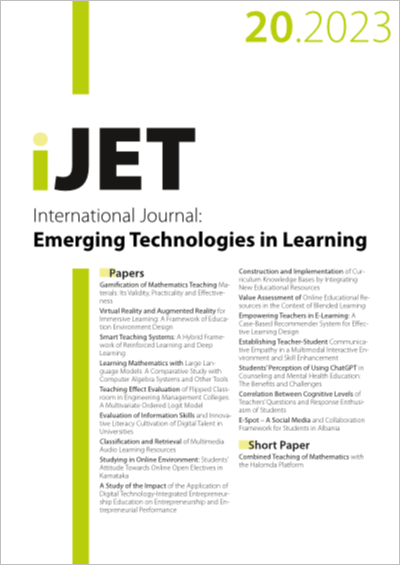Virtual Reality and Augmented Reality for Immersive Learning: A Framework of Education Environment Design
DOI:
https://doi.org/10.3991/ijet.v18i20.44209Keywords:
immersive learning environment, network topology, visual layout, edge strategy, visual optimization, non-local feature fusion, panoramic view, super resolution algorithmAbstract
The technologies of virtual reality (VR) and augmented reality (AR) have developed fast in recent years and have been applied in various scenarios, including the field of education. Now educators attempt to make use of these new technologies to create an immersive learning environment (ILE) for students, in the hopes of helping them improve learning efficiency and quality. Currently, available research on the design and optimization of ILE focus on how to introduce teaching content into the 3D environment and improve user experience, while a series of problems are still pending for solutions, such as how to arrange the layout in multi-dimensional space, how to optimize the vision in immersive environment based on edge strategy, and how to improve image quality using panoramic-view specific-region super-resolution (PSS) algorithms that use non-local feature fusion. In view of these matters, this study proposed a novel method for the design and optimization of an ILE. At first, problems of how to create a visual layout of network topology in the ILE, how to arrange the layout based on the advantages of different-dimensional spaces in scenes, and how to carry out visual optimization combined with the edge strategy were discussed in detail. Then, a new PSS algorithm that utilizes non-local feature fusion was proposed, and the functioning of the multi-scale non-local feature fusion module and the specific structure of the high-solution network were introduced in detail. The findings of this study could provide useful theoretical evidences and practical guidance for the design and optimization of ILE, giving new possibilities for improving the effect of ILE and enhancing user experience.
Downloads
Published
How to Cite
Issue
Section
License
Copyright (c) 2023 Nan Zhang (Submitter); Biqin Yang

This work is licensed under a Creative Commons Attribution 4.0 International License.


